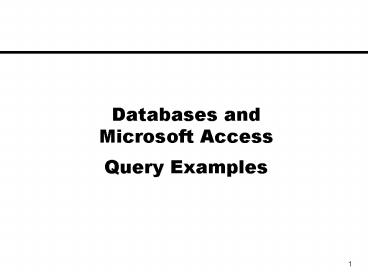Databases and Microsoft Access Query Examples - PowerPoint PPT Presentation
1 / 25
Title:
Databases and Microsoft Access Query Examples
Description:
You can specify an exact match condition, which allows you to specify that only ... When you run the query after specifying an exact match, only those records that ... – PowerPoint PPT presentation
Number of Views:54
Avg rating:3.0/5.0
Title: Databases and Microsoft Access Query Examples
1
Databases and Microsoft AccessQuery Examples
2
Specifying Conditions in a Query
- You can specify an exact match condition, which
allows you to specify that only records that
match your criteria will be displayed. - To specify an exact match, use the criteria row
in your query design grid. - When you run the query after specifying an exact
match, only those records that meet the criteria
will be displayed. - An exact match condition specifies that the value
in the specified field must match the condition
exactly.
3
Exact Match Operators and Results
4
And and Or Logical Operators
- When you need to use multiple conditions for a
query, you can use the logical operators to
combine conditions. - The And logical operator specifies that both
conditions must be met - The Or logical operator specifies that one or the
other of the conditions must be met - When you enter two conditions on the same row of
the query design grid, an And condition is
created. - If you enter two conditions that are on separate
rows, an Or condition is created.
5
And and Or logic
The And condition.
The Or condition.
6
And / Or Conditions in Design Grid
7
Perform Calculations in a Query
- Queries can be built to perform a calculation as
part of the query. - Expressions can be entered into the query design
grid. - Make certain that you are following the rules of
precedence. - To perform a calculation in a query, you must add
a calculated field to the query design. - You have three options for entering expressions
- Enter the expression directly into the field text
box - Enter the expression in the Zoom box
- Enter the expression in the Expression Builder
8
Expression Builder dialog box
9
Calculated Field in the Datasheet
Expression Builder adds your calculated field to
the query design grid. You can then assign it a
name, which will display in query datasheet view
when the query is run.
10
Using Aggregate Functions
Access has several Aggregate Functions that can
be used to calculate various statistical
information.
Aggregate functions are specified in the Total
row of the design grid. They can be assigned by
clicking the Totals button on the Query Design
toolbar.
11
Query Examples 1
- Query to display
- EmployerName, City, PositionTitle, Wage,
Hours/Week, StartDate - Sort by StartDate
- Limit to Hours/Week greater than 35
12
Query Examples 1
- Query to display
- EmployerName, City, PositionTitle, Wage,
Hours/Week, StartDate - Sort by StartDate
- Limit to Hours/Week greater than 35
13
Query Examples 2
- Query to display
- EmployerName, NAICSDesc, PositionTitle, Wage,
Hours/Week, StartDate - with Wage gt 15 AND starting date after 10/1/2004
14
Query Examples 2
- Query to display
- EmployerName, NAICSDesc, PositionTitle, Wage,
Hours/Week, StartDate - with Wage gt 15 AND starting date after 10/1/2004
15
Query Examples 3
- Query to display
- EmployerName, PositionTitle, Wage, Hours/Week,
StartDate - with Wage gt 20 OR starting date after
12/1/2004 - Sort by start date
16
Query Examples 3
- Query to display
- EmployerName, PositionTitle, Wage, Hours/Week,
StartDate - with Wage gt 20 OR starting date after
12/1/2004 - Sort by start date
17
Query Examples 4
- Query to display
- EmployerName, City, PositionTitle, Wage,
StartDate - all positions in Massachusetts that pay more
than 18 per hour
18
Query Examples 4
- Query to display
- EmployerName, City, PositionTitle, Wage,
StartDate - all positions in Massachusetts that pay more
than 18 per hour
19
Query Examples 5
- Query to display
- Employers and their addresses, whose name
contains the word Resort
Note that the wildcard character is used
before and after the word Resort
20
Query Examples 5
- Query to display
- Employers and their addresses, whose name
contains the word Resort
21
Query Examples 6
- Query to display Weekly wages for all positions
- Note that this is a calculated field which
shows up as a new column - Calculation is based on an expression entered
as the field name
22
Query Examples 6
Query to display Weekly wages for all positions
Note The name of the expression used for the
calculated field will appear as the column name
in the query results.
23
Query Examples 7
- Query to compute Total number of positions,
average Wage, and sum of all the Weekly Hours. - This type of query is performed using
aggregation functions - You can get the Group by boxes added to the
query design view by selecting the S icon from
the menu bar. Clicking in the box allows you to
choose from built-in functions such as Count,
Sum, Avg, etc.
24
Query Examples 7
In this case, we select Count for PositionID (to
count the number of positions), Avg for the Wage
column, and Sum for the HourPerWeek column.
25
Query Examples 7
Query to compute Total number of positions,
average Wage, and sum of all the Weekly Hours. ?
The datasheet view will show a single row with
the computed values for three new fields
CountOfPositionID, AvgOfWage, and
SumOfHoursPerWeek.






























![[Latest Update] Microsoft DP-300 Actual Exam Practice Questions Shared Online PowerPoint PPT Presentation](https://s3.amazonaws.com/images.powershow.com/10142373.th0.jpg?_=20240928037)
![[Latest Update] Microsoft DP-420 Actual Exam Practice Questions Shared Online PowerPoint PPT Presentation](https://s3.amazonaws.com/images.powershow.com/10142375.th0.jpg?_=20240928037)